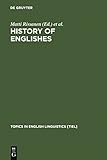History of Englishes : New Methods and Interpretations in Historical Linguistics / ed. by Irma Taavitsainen, Matti Rissanen, Ossi Ihalainen, Terttu Nevalainen.
Material type: TextSeries: Topics in English Linguistics [TiEL] ; 10Publisher: Berlin ; Boston : De Gruyter Mouton, [2011]Copyright date: ©1992Edition: Reprint 2011Description: 1 online resource (799 p.) : Num. figsContent type:
TextSeries: Topics in English Linguistics [TiEL] ; 10Publisher: Berlin ; Boston : De Gruyter Mouton, [2011]Copyright date: ©1992Edition: Reprint 2011Description: 1 online resource (799 p.) : Num. figsContent type: - 9783110132168
- 9783110877007
- 425 .09 20
- PE1101
- online - DeGruyter
- Issued also in print.
| Item type | Current library | Call number | URL | Status | Notes | Barcode | |
|---|---|---|---|---|---|---|---|
 eBook
eBook
|
Biblioteca "Angelicum" Pont. Univ. S.Tommaso d'Aquino Nuvola online | online - DeGruyter (Browse shelf(Opens below)) | Online access | Not for loan (Accesso limitato) | Accesso per gli utenti autorizzati / Access for authorized users | (dgr)9783110877007 |
I-IV -- Preface -- Contents -- I. Theory and methodology -- Translation and the history of English -- The evidence for analytic and synthetic developments in English -- Evidence for regular sound change in English dialect geography -- A social model for the interpretation of language change -- How to study Old English syntax? -- II. Phonology and orthography -- Exceptionality and non-specification in the history of English phonology -- The myth of "the Anglo-Norman scribe" -- Old English ABCs -- What, if anything, was the Great Vowel Shift? -- Lexical and morphological consequences of phonotactic change in the history of English -- Lexical phonology and diachrony -- Homorganic clusters as moric busters in the history of English: the case of -ld, -nd, -mb -- Middle English vowel quantity reconsidered -- III. Morphology and syntax -- On explaining the historical development of English genitives -- A touch of (sub-)class? Old English "Preterite-Present" verbs -- The information present: present tense for communication in the past -- Structural factors in the history of English modals -- Subordinating uses of and in the history of English -- The distribution of verb forms in Old English subordinate clauses -- Relative constructions and functional amalgamation in Early Modern English -- The use of to and for in Old English -- Man's son/son of man: translation, textual conditioning, and the history of the English genitive -- Why is the element order to cwæð him 'said to him' impossible? -- On the development of the by-agent in English -- Pragmatics of this and that -- A valency description of Old English possessive verbs -- Who(m)? Constraints on the loss of case marking of wh-pronouns in the English of Shakespeare and other poets of the Early Modern English period -- "I not say": bridge phenomenon in syntactic change -- IV. Lexis and semantics -- The status of word formation in Middle English: approaching the question -- Post-dating Romance loan-words in Middle English: Are the French words of the Katherine Group English? -- Rich Lake: a case history -- V. Varieties and dialects -- The evolution of a vernacular -- Relativization in the Dorset dialect -- William Barnes and the south west dialect of English -- A Linguistic Atlas of Early Middle English: the value of texts surviving in more than one version -- A Linguistic Atlas of Early Middle English: tradition and typology -- A chapter in the worldwide spread of English: Malta -- "Du's no heard da last o'dis" — on the use of be as a perfective auxiliary in Shetland dialect -- On the morphology of verbs in Middle Scots: present and present perfect indicative -- The pace of change in Appalachian English -- Variability in Old English and the Continental Germanic languages -- Variability in Tok Pisin phonology: "Did you say 'pig' or 'fig'?" -- VI. Text types and individual texts -- Chaucer's Boece: a syntactic and lexical analysis -- The linguistic evolution of five written and speech-based English genres from the 17th to the 20th centuries -- The do variant field in questions and negatives: Jane Austen's Complete Letters and Mansfield Park -- The repertoire of topic changers in personal, intimate letters: a diachronic study of Osborne and Woolf -- Text-types and language history: the cookery recipe -- Macaronic writing in a London archive, 1380—1480 -- Abbreviations of titles of textual sources -- Name index -- Subject index -- 800
restricted access online access with authorization star
http://purl.org/coar/access_right/c_16ec
Issued also in print.
Mode of access: Internet via World Wide Web.
In English.
Description based on online resource; title from PDF title page (publisher's Web site, viewed 28. Feb 2023)


